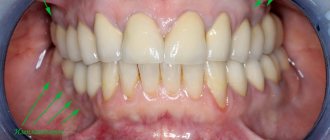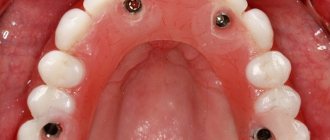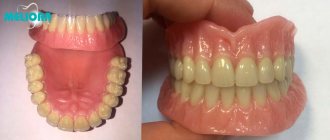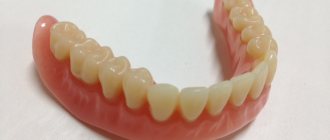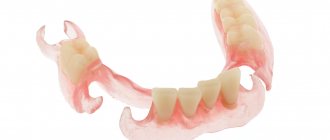Chief editor of the site:
Snitkovsky Arkady Alexandrovich
Chief physician of the professorial dentistry “22 Century”, dentist, orthopedic dentist
Author of the article:
Scientific team of dentistry “22 Century”
Dentists, candidates and doctors of medical sciences, professors
Dental prosthetics is a sequential multi-stage process. It is the high-quality implementation of each of them that leads to an excellent final result. There are main stages of prosthetics , some of them have their intermediate stages. They can also be clinical, that is, performed in a doctor’s office, and laboratory, in a dental laboratory. The main ones include: examination, preliminary treatment, prosthetics. The last stage includes the restoration of supporting teeth , their preparation, taking impressions, determining the closure of the jaws, fixing temporary structures, fitting and fixing permanent dentures and an adaptation period. Laboratory stages are carried out by a dental technician after taking impressions and determining occlusion (closing of the jaws). Before starting any treatment, it is necessary to draw up a treatment plan.
Oral examination
Any treatment process must begin with an examination. A preliminary examination allows you to determine the need for prosthetics, choose the optimal type of design and amount of work.
Examination of the oral cavity in dentistry Additional examination (instrumental, x-ray, etc.) provides information about the condition of the supporting teeth, periodontal tissue, bone tissue, the need for root canal treatment, and the possible presence of inflammatory elements at the tops of the root canals or in the bone.
This is an integral stage of successful prosthetics, as it allows not only to identify and eliminate hidden problems, but also to avoid possible complications in the future, after installation of the prosthesis .
How long does it take to prepare directly in dentistry?
Once you have decided on a clinic and specialist, the preparatory stage of treatment begins. It is very difficult to say how long it will take on average to prepare for prosthetics. But in any case, you shouldn’t expect to complete it in one day. For each patient, the timing is individual, as it depends on a number of factors: the initial condition of the oral cavity, the presence or absence of chronic diseases, absolute and relative contraindications to a particular method, the chosen treatment plan and the type of orthopedic design.
If a patient is going to put an inlay or crown on one decayed tooth, or install veneers, and all this provided that there are no serious bite pathologies and other contraindications, that’s one thing. It may only take a few weeks from the first visit to the clinic to receiving a permanent structure. Approximately the same amount of time can be spent preparing to fix bridges if one or more row elements are missing.
If a patient is hoping to undergo implantation to restore missing teeth, this is a completely different approach. It must be taken into account that tests must be taken before this. In some cases (with atrophy of the jaw bone), an implant cannot be placed without bone grafting, after which you have to wait another 5-8 months for tissue healing.
It is also important to understand that there are different implantation protocols - they directly determine when the prosthetic stage itself will be carried out. Thus, one-stage technology allows you to install dentures on the same day or 2-3 days after installing the implants. But the two-stage method involves the use of removable dentures until the implant finally takes root in the bone - this takes about 3-6 months.
Please pay attention to another important point that may delay preparation. And not even for a few months, but for several years. We're talking about an incorrect bite. Or about the displacement of neighboring teeth in place of lost ones, if the patient did not take action for a long time. In these cases, even the restoration of one element of a series (for example, a bridge, a crown on an implant) can be difficult, since there are no conditions for installing a full-fledged functional structure and there is not enough space. Then you first need to undergo correction of pathologies with the help of orthodontic devices (braces, mouth guards, trainers) - this may take 1-2 years.
Preliminary treatment
Dental treatment is an important point not only before prosthetics or implantation, but throughout life. Timely sanitation of the oral cavity preserves the health and integrity of the dental system, avoids possible complications, as well as the spread of infection throughout the body. Treatment of abutment teeth , hidden and obvious carious cavities, acute inflammatory processes in periodontal tissues or bones is mandatory before starting any prosthetics. This will allow not only to eliminate defects or diseases that have arisen in a timely manner, but also to extend the service life of the prosthesis. Also, some fixed structures require mandatory endodontic treatment.
Stages of dental prosthetics
Rarely does dental prosthetics happen in a single stage; generally, it is a sequential, multi-stage process. After preliminary endodontic treatment, it is necessary to restore the supporting teeth using inlays or pins. Then the doctor prepares (grinds) them to create a place for the prosthetic structure, takes impressions from both jaws and the prosthetic area, and determines the color of the artificial teeth. A very important step in prosthetics is determining the occlusion (the relationship of the jaws), which allows you not to interfere with the prosthesis during chewing.
The impressions are sent to the dental laboratory. This is a kind of information for a dental technician about the shape and size of the teeth, the anatomical features of the prosthetic bed, the location and type of structure. Based on the impressions obtained, the dental technician casts diagnostic and working models from plaster, which are an exact copy of the teeth, and in the case of complete edentia, the gums. Next, the structure itself is modeled with wax and the prosthesis itself is created using various methods and techniques. Sometimes during its manufacture it requires checking, fitting and fitting. The finished structure is fixed in the oral cavity. In some cases, additional correction of the prosthesis is required during the adaptation period.
Frequently asked questions and answers
Is it safe to screw implants into the jaw?
Dental prosthetics in 1 day is safe and slightly depends on the quality of the prosthesis. Artificial roots are implanted only into strong areas of the jaw bone that are not subject to inflammation and erosion. The structure of the implant neck does not have grooves or depressions, which eliminates the accumulation of dental plaque and, consequently, the occurrence of a source of infection and inflammation.
How is it possible to attach an implant if bone tissue is reabsorbed?
We used a unique find - the inclination of each structural element - in the TiS method. When tilted, the area of the implanted pin affects the maximum space of bone tissue and leaves space to go around problem areas. The procedure for teeth in one day, even if there are problems with gums, is recommended for most patients due to the special models of implants. They allow our doctors to operate in almost any plane, affecting the deeper parts of the jaw and bypassing the superficial tissues.
Is it possible to get new teeth on the day of surgery?
This is not only real, but also helps to quickly get used to the prosthesis. There are at least 4 more reasons why we recommend our patients simultaneous implantation with installation of a prosthesis:
1 – Fast recovery. Full chewing increases blood circulation and other metabolic processes, against the background of which tissue regeneration increases. 2 – The patient leaves the office, although a little swollen, but with a real smile. 3 – The presence of dentures additionally fixes and adapts the implants, allowing them to take a strong position in the gums. 4 – The patient can chew with his own jaws without any problems the very next day.
What are the disadvantages of Teeth in a Day methods?
The only drawback is the lack of extensive practice among current doctors. Only in 2021 did certified training in prosthetic technology begin in Russia, and before this period only a few doctors mastered this practice abroad. Among them is our chief doctor, Alexander Leonidovich, who already in 2004 was one of the first to install inclined implants for Russians. A doctor using such a technique is required to have the qualifications of a maxillofacial surgeon and an implant surgeon. But this is not enough. You need years of experience, under the guidance of a guru, in one-step prosthetics.
The chief physician of the All on 4 Center, Alexander Leonidovich Krushev, has more than 35 years of real clinical experience, and has undergone training and internships in the best clinics in Japan, Portugal, Israel, Korea, Spain and America. His fellow doctors working at the center learn from their experience and become worthy specialists who are not afraid to undergo treatment.
We have already helped 1,470 patients and installed more than 7,000 implants.
Under the auspices of the All-on-4 Center in St. Petersburg, we have gathered leading practicing implant surgeons who are able to help patients even in very advanced situations. As proof of our professionalism, Nobel Biocare asked us to become the first specialized All on 4 center in Russia.
Stages of dental prosthetics with metal-ceramics
process of metal-ceramic dentures begins with the preparation of previously prepared abutment teeth and obtaining a two-layer impression.
Bridges They are removed with special elastic masses, which allows the dental technician to accurately convey information about the shape, size and location of the teeth and the orthopedic structure.
Next, temporary crowns or bridges are fixed onto the prepared teeth in order to temporarily restore the cosmetic defect and prevent changes and displacement of the tissues of the prosthetic bed. Central occlusion is determined - the nature of the closure of the teeth of both jaws. All received data is transferred to the dental laboratory. At the next visit, the solid metal frame of the prosthesis is fitted and the color of the ceramic veneer is determined and sent back to the laboratory for ceramic veneering. On the third visit, the doctor fits and temporarily fixes the finished metal-ceramic prosthesis . Sometimes at this visit the prosthesis is fixed with permanent cement. Temporary fixation allows, if necessary, to adjust the prosthesis during the adaptation period.
Bridge
The main preparation for bridge prosthetics consists of preparing the supporting teeth. When using metal-ceramic dental prosthetics, the teeth are subjected to significant grinding. Zirconium crowns are much thinner, so not as much hard tissue is ground down.
After this, impressions are made and the frame is modeled based on them. Then the crowns are cast and fired in a kiln. The bridge is tried on, adjusted and placed on temporary cement, giving the patient time to get used to it. After this, the structure is secured with permanent cement.
Stages of dental prosthetics with inlays
Ceramic inlays are a type of microprosthetics, which is a modern alternative to conventional fillings. They fill previously prepared cavities in the teeth, restoring their shape and function. The indication for ceramic inlays is the ability to save a tooth with significant destruction of its coronal part (up to 65%).
At the initial stage of tooth preparation, the doctor removes all tissue destroyed by the carious process and, if necessary, carries out endodontic treatment. After the tooth is cured, an impression is taken and sent to the laboratory, where a ceramic inlay is made . At the next visit, the finished structure is fixed to the tooth using special cement. Ceramic inlays have high strength and durability, and are color resistant to food coloring. They are also highly aesthetic.
Stages of dental prosthetics with complete edentia
The production of a complete removable denture begins with an examination of the patient’s oral cavity, diagnosis of the condition of the dental system, and selection of a suitable design. The first impression is taken with a standard impression tray. Depending on which design is chosen, the impression mass is selected. The impressions are sent to the laboratory, where a dental technician casts plaster models and makes a wax base with occlusal ridges and custom impression trays.
On the second visit, using these trays, the doctor takes functional impressions, and using rollers, determines and fixes the occlusion. All information is transmitted to the dental technician. He makes the future prosthesis from wax with acrylic (plastic) teeth .
On the third visit, the structure in the oral cavity is checked, occlusion, fit, and the appearance of the patient’s face are assessed. The doctor makes the necessary notes and corrections and transfers the future design to the laboratory. The dental technician finally models the wax structure, plaster it into a cuvette where the wax is replaced with plastic. Next, he grinds and polishes the finished prosthesis.
At the next visit, the prosthesis is handed over. Finished structures are fitted, fit, occlusion and aesthetics are checked. The doctor will tell the patient how to use and care for the new prosthesis. During the adaptation period, additional corrections are possible.
Stages of prosthetics with veneers
Veneers are thin ceramic plates that are fixed to the front surface of previously prepared teeth and allow them to correct cosmetic defects, change shape, size and color.
Crowns and veneers The first stage, as with any prosthetics, is a survey, examination and
diagnosis of the oral cavity .
If necessary, X-ray and laboratory tests are performed. A very important stage is planning future structures, taking into account not only the condition of the teeth and oral cavity, but also the gender, age, and character of the patient. The shape of the face, the gingival margin and smile line, and the individual characteristics of the teeth are assessed. The size of the veneers is predicted and calculated. A photographic record is being taken. The doctor models the future restoration on a computer using a special program and demonstrates the result to the patient. At the next visit, the teeth are prepared, starting with cleaning their surfaces from plaque. The required shade of filling material is selected. Under anesthesia, the front surface of the teeth is prepared and the required amount of enamel is removed. The next step is taking impressions. Based on the dental impressions obtained, a plaster model is cast in the laboratory to obtain an exact copy of the patient’s teeth, on which the dental technician makes future veneers. After the doctor has prepared the teeth, temporary veneers . A dental technician, using computer systems, special scanners, sensors and ovens, produces structures strictly according to the specified parameters.
At the next visit, the doctor tries on the finished structures. If necessary, adjustments are made, deficiencies are eliminated, and the bite is checked. Veneers are fixed to the teeth using special cement.
Fixation of dentures
Fixing agents are used only if removable dentures are installed, since they allow the structure to stay more firmly in the oral cavity and also have a shock-absorbing effect, reducing irritation of soft tissues. Most of these products also have antibacterial properties.
Cream for fixing dentures
These include:
- fixing creams, gels, adhesives - they are applied to the surface of the prosthesis adjacent to the patient’s tissues, strictly according to the instructions (some are applied only to dried mucosa); Please note that creams and gels have different durations of action: the widely advertised Corega cream lasts 3–4 hours, Rocs cream lasts up to 12 hours (optimal duration), and Lacalut - 24 hours; You should also keep in mind that some fixatives contain zinc, which has a good anti-inflammatory effect; but with prolonged use of such drugs, an overdose of zinc occurs, which is harmful to the body, therefore zinc-containing fixatives can only be used in courses of 3 to 4 weeks with long breaks;
- powdered products - sprayed onto the surface of the removable dental prosthesis, then the product is put on in the usual way and lightly pressed against the gums and palate;
- strips of fabric - designed to tightly fix a removable denture in the absence of teeth and make it more comfortable to wear.
An orthopedic dentist will help you choose the right fixation agent.
